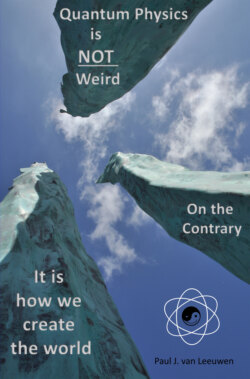Читать книгу Quantum Physics is not Weird. On the Contrary. - Paul J. van Leeuwen - Страница 33
На сайте Литреса книга снята с продажи.
Harmonic electron waves
ОглавлениеFigure 4.9: Seven harmonically vibrating modes of a string. From tonic to 6th harmonic.
Bron: Wikimedia Commons.
A vibrating string has only very specific ways in which a standing wave can arise and continue. The condition is that an integer number of half wavelengths fits exactly on the length of the string. Which means ½λ, 1λ, 1½λ, 2λ, 2½λ, etc. You get the lowest vibration - the tonic - if exactly ½λ fits on the string, with 1λ fitting you get the 1st harmonic, with 1½λ fitting on the string you get the 2nd harmonic, and so on. This means that there will always be a lowest vibration for a given string, to evoke a lower tone is impossible. The possible vibrations are clearly 'quantized' and have a lowest limit value. This phenomenon inspired a prince to a rather daring idea.
Thinking about Bohr's still enigmatic atomic model and well aware of Einstein's photons - EM-waves behaving as particles - Prince Louis Victor de Broglie (1892-1987) connected in 1923 the dots and supposed that if a wave could be a particle, the other way around also might be true. Could it be that those enigmatic Bohr electron orbits were standing electron waves?
If electrons also behaved like waves, then their waves would only fit on their orbits around the nucleus in certain ways, just like standing waves on vibrating strings. When the electron wavelength fitted exactly on circular orbits of 1 λ, 2 λ, 3 λ, etc. this would result in standing electron waves.
De Broglie knew that a moving a particle, such as an electron, has a certain momentum p = m.v, where m.v denotes mass x speed. Combining this momentum with the Planck formula for the energy of a light particle and Einstein's energy-mass equivalence, he proposed that this determined the associated wavelength of a moving electron. A photon has an associated wavelength and also an associated momentum, something that was already confirmed by the photoelectric effect [21]. Combining E = h.f, E = m.c2 and p = m.v he arrived at a very simple formula for the wavelength of an electron: λ = h/(mv) or λ = h/p. This means that the greater the speed v is, the shorter the associated electron wavelength will be. When jumping to a higher orbit the speed of the electron will be slowed down and its wavelength will therefore change accordingly.
Figure 4.10: The first four De Broglie harmonic electron orbits in the hydrogen atom.
Figure 4.10 shows the De Broglie standing electron waves, from left to right, for the lowest orbit, the "tonic" (n = 1), up to and including the 4th orbit (n = 4), the 3rd "harmonic". Incidentally, upon further study of those De Broglie orbits I hope you will notice that, unlike with the vibrating string with fixed ends, one complete wavelength fits on the lowest orbit, on the next orbit fit two complete wavelengths, etc. Standing wave orbits are not possible with an odd number of half wavelengths. This has to do with the fact that after having traveled a full orbit, the moving wave front has to arrive exactly in phase with its 'tail' to constructively interfere. The electron wave just travels around and is not reflected at any boundary as happens in a vibrating string. Reflecting on fixed boundaries invokes 180o phase shifts which corresponds to halved wavelengths. In short, only complete wavelengths are suitable for circular standing waves [22].
Only four years later De Broglie's hypothesis became confirmed experimentally, albeit in a rather circuitous way. Coincidence - serendipity - played a major role. The wave character of electrons was demonstrated in 1927 by Clinton Davisson (1881-1958) and Lester Germer (1896-1971) in experiments where electrons were reflected on a crystal lattice of nickel. The results of their experiment, preferred directions in which the scattered electrons reflected, could only be explained with interference - which implied wave behavior. This is in fact the same line of thought that Young followed with his double-slit experiment in 1805. Interference presumes waves.
Two years after the confirmation of electron waves by Davisson and Germer, Louis De Broglie received the physics Nobel Prize in 1929. Which was a well-earned recognition for his bold out-of-the-box thinking. For a good understanding of what the Davisson-Germer experiment entailed and what it confirmed, we should first pay some attention to diffraction grids.
